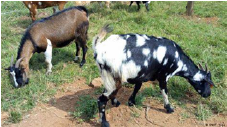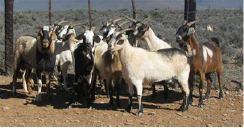
Small ruminant production in Uganda

Small ruminants are kept for milk, meat and skins. The main animals here are sheep and goats
Systems of small ruminant production in Uganda
In Uganda, there are two main systems i.e. tethering and open grazing though zero grazing is also being practiced in the breeding stock.
Tethering

Here, sheep or goats are tethered using ropes of about 3m long that allows grazing in a limited area.
The animals can be given green supplements on top of tethering.
Open Grazing

The small ruminants are allowed to graze freely in uncultivated land or a garden with crop residues. This system is common in arid and semi-arid areas with low human population.
Breeds of goats in Uganda
- Small East African Goats:

This is the largest breed in Uganda making up to 42% of the total goat population.
Characteristics
- they are small in size
- they mature early reaching a live weight of about 23 – 30kg
- they reach sexual maturity at about 4 months
- they have a fine hair coat with various color
- Most of them are horned and they are mainly kept for meat.
- Mubende Goat

This is found in areas of North and North West of Lake Victoria.
Characteristics
- It is a larger breed than the small East African goat.
- The mature live weight ranges between 30 – 35 kg for males and 25 – 30kg for the females
- It has straight and short hairs
- it is predominantly black in color though black and white are other color.
- It has a long neck
- The body conformation of the female is angular
- Kigezi goats

This is usually found in the highlands of south Western Uganda
Characteristics
- it has a thicker hairy coat than the other two breeds
- it has spaced long hair around the hind quarters
- It is small, more compact with short legs.
- They have black and grey hair coat
- At maturity , they can weigh between 25 – 30kg
Sheep

The main breeds of sheep reared in Uganda are:
- Red Masai sheep
- East African black head sheep
- East African long tailed sheep
Advantages of raring small ruminants
- They require small initial capital so poor people can easily start such a venture without much external financial assistance.
- Their reproduction turnover is high i.e. they have short gestation period and frequently deliver twins
- They can be easily managed by family labor i.e. women and children
- They can be easily kept in mountainous and dry areas where cattle can’t do well
- They can be combined with beef cattle utilizing the same land and farm facilities with less competition for food
- Indigenous breeds of these small ruminants are resistant to the number of diseases which affect cattle including East coast Fever.
- They have a big genetic variation giving room for improvement by selection
- There is ready market for their product more especially meat locally and for export.
- It is safer to keep small ruminants in areas with cattle rustlers since little interest is accorded to them.
- They can tolerate contamination of drinking water
- Can survive in a wide range of environmental temperatures
- Need limited land for grazing hence good for densely populated areas
Constraints to small ruminant production in Uganda
- Lack of sound breeding males and defective breeding practices
- Most farmers in Uganda have poor management skills
- The animals are attacked by internal parasites which are difficult to control
- The indigenous breeds are being threatened by neglect in preference for the highly productive exotic breeds
- Inadequate extension services amongst farmers limiting information about small ruminants
- The marketing system in Uganda is still poor where animal prices are determined by their size rather than actual weight.
Please leave a comment
Dr. Bbosa Science

I don’t think the title of your article matches the content lol. Just kidding, mainly because I had some doubts after reading the article.